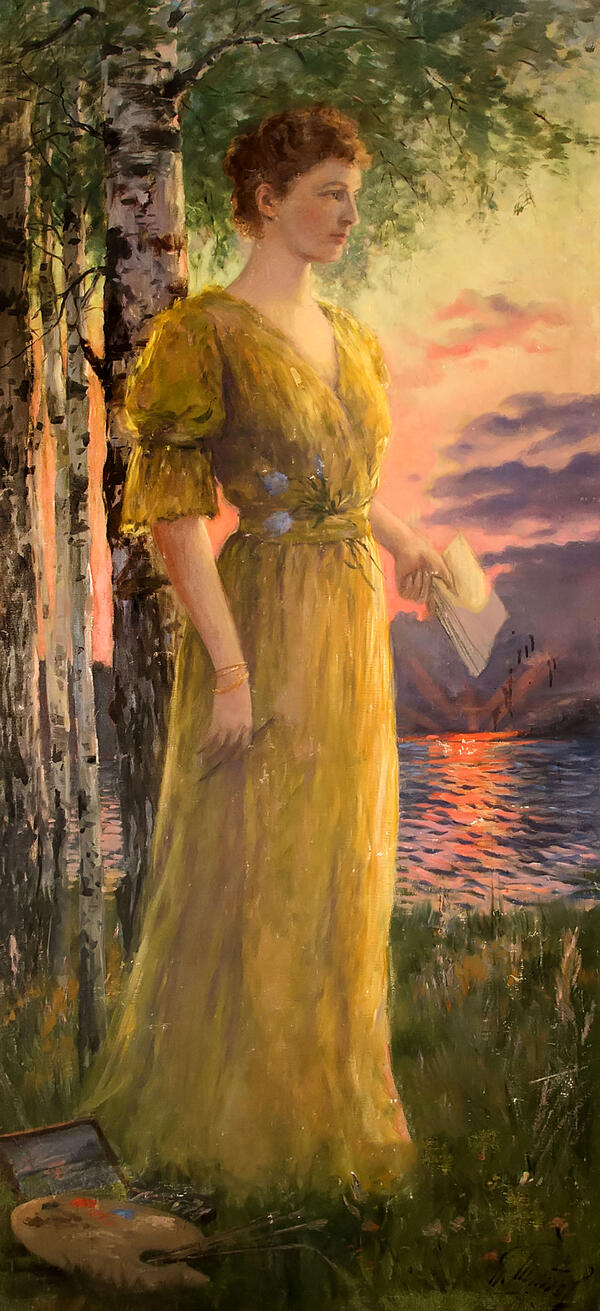Nadezhda Boratynskaya was the wife of Alexander Boratynskiy, grandson of the poet Evgeniy Boratynskiy. She was born into the family of prominent public figure Dmitry Shipov. In 1891, she married and had three children. In 1903, Nadezhda died unexpectedly of scarlet fever, while caring for her sick son.
The story of this portrait was described in the memoirs by Ksenya Boratynskaya: ‘Nadezhda’s brother Pavel Shipov came from Petersburg. He and Alexander were grieving this terrible loss. He spent days at the easel. He was painting a portrait of Nadezhda from memory’.
Pavel Shipov was an artist, a master of the military portrait. From 1875 he studied as a non-resident student at the Academy of Arts in Petersburg. Throughout his life, Shipov was engaged in painting without abandoning his military service.
As an artist, he mainly painted portraits of soldiers, observing them both in combat and while they rested. He painted pencil sketches and watercolor portraits. He was one of the main representatives of the Russian military portrait of the turn of the century. His paintings depict the lives and mores of the military class.
The story of this portrait was described in the memoirs by Ksenya Boratynskaya: ‘Nadezhda’s brother Pavel Shipov came from Petersburg. He and Alexander were grieving this terrible loss. He spent days at the easel. He was painting a portrait of Nadezhda from memory’.
Pavel Shipov was an artist, a master of the military portrait. From 1875 he studied as a non-resident student at the Academy of Arts in Petersburg. Throughout his life, Shipov was engaged in painting without abandoning his military service.
Nadezhda Boratynskaya was the wife of Alexander Boratynskiy, grandson of the poet Eugene Boratynskiey. She was born into the family of prominent public figure Dmitry Shipov. In 1891 she married and had three children. In 1903, Nadezhda died unexpectedly of scarlet fever, while caring for her sick son.
As an artist, he mainly painted portraits of soldiers, observing them both in combat and while they rested. He painted pencil sketches and watercolor portraits. He was one of the main representatives of the Russian military portrait of the turn of the century. His paintings depict the lives and mores of the military class.
A contemporary recalled: “He carried his paint box on a march and sometimes sat down to write sketches on some hill under the intermittent fire of the enemy. All his behavior and attitude towards people was channeling the medieval “without fear and beyond reproach” knighthood. Shipov remained a loner, fully devoted to painting and the military. These two arts were intermingled with him as he painted and did exclusively battle paintings’.
The real portrait bears the traces of a pogrom in the Boratynskiy house in the autumn of 1918: traces of blood found on the canvas during the restoration, and several mechanical ruptures at the bottom of the painting. The latter were successfully eliminated during the restoration.
The real portrait bears the traces of a pogrom in the Boratynskiy house in the autumn of 1918: traces of blood found on the canvas during the restoration, and several mechanical ruptures at the bottom of the painting. The latter were successfully eliminated during the restoration.



